User:Cease/Temp4: Difference between revisions
| Line 55: | Line 55: | ||
== Gimli and Slaked Thirsts == | == Gimli and Slaked Thirsts == | ||
[[Gimli]]—almost always {{Card|Gimli, Bearer of Grudges}} or {{Card|Gimli, Feared Axeman}}—can bring a lot to a Rainbow Wounding deck. The main benefit to having him is {{Card|Preparations}} and {{Card|Slaked Thirsts}}. Not only is Slaked Thirsts a powerful card, placing two wounds for the cost of one exertion, you don't need to keep Gimli healthy to use it. You can make sure any excess healing (for example, from a [[sanctuary]]) won't go to waste by using it to place Slaked Thirsts on Preparations. Any extra copies of Preparations won't go to waste either, since they can be used as a (weak) direct-wounding card. If you draw Slaked Thirsts, you can play it when you have exactly three other cards in hand to quickly lose then regain initiative for the other cultures' initiative [[condition]]s. Slaked Thirsts is | [[Gimli]]—almost always {{Card|Gimli, Bearer of Grudges}} or {{Card|Gimli, Feared Axeman}}—can bring a lot to a Rainbow Wounding deck. The main benefit to having him is {{Card|Preparations}} and {{Card|Slaked Thirsts}}. Not only is Slaked Thirsts a powerful card, placing two wounds for the cost of one exertion, you don't need to keep Gimli healthy to use it. You can make sure any excess healing (for example, from a [[sanctuary]]) won't go to waste by using it to place Slaked Thirsts on Preparations, and Bearer of Grudges with {{Card|Answer to All Riddles}} has a deep wound pool and is unlikely to take any unexpected wounds against many Shadow sides. Any extra copies of Preparations won't go to waste either, since they can be used as a (weak) direct-wounding card. If you draw Slaked Thirsts, you can play it when you have exactly three other cards in hand to quickly lose then regain initiative for the other cultures' initiative [[condition]]s. Like {{Card|Shadowplay}} above, Slaked Thirsts is a powerful tool for stymieing obnoxious [[hate]] cards like {{Card|Grima, Chief Counselor}}, {{Card|Grima, Wormtongue}}, or {{Card|Ulaire Enquea, Lieutenant of Morgul}}. Compared to Slaked Thirsts, the {{C|Dwarven}} wounding cards are fairly anemic. {{Card|Quick As May Be}} is cheap and basically free, so it's worth finding space for sometimes. {{Card|Baruk Khazad}} can be useful, but it isn't as strong as Slaked Thirsts and can't easily be replayed. | ||
Having a single dwarf in your deck also opens up a lot of other cards, especially if your deck already has lots of healing. {{Card|Ever My Heart Rises}} (generally [[download]]ed with {{Card|Dunharrow Plateau}}) can help your deck set up more consistently to start, as long as you can don't mind [[mill]]ing yourself a little bit. {{Card|Gimli's Battle Axe, Trusted Weapon}} contributes an extra archery wound once some [[threat]]s are stacked, although some decks instead use {{Card|Axe of Erebor}} since it can get a strength bonus freeing up any Shadow cards stuck on EMHR. {{Card|Blood Runs Chill}} can discard some minions who survived the [[skirmish phase]] or clean out your opponent's [[support area]]. {{Card|Ring of Fury}} is a good choice to help protect Gimli, and it also boosts Blood Runs Chill and can be [[download]]ed with {{Card|The Binding Ring}} | The next most-important reason to bring Gimli is {{Card|Shoulder to Shoulder}}. If you're bringing {{Card|Legolas, Greenleaf}}, the two of them can share their vitality pool for Greenleaf's exertion ability or Preparations. As with the {{C|Elven}} contingent above, adding in {{Card|Elrond, Herald to Gil-Galad}} gives them a powerful source of healing every single turn, at the cost of generating some [[twilight]] in the [[Maneuver Phase]]. | ||
Having a single dwarf in your deck also opens up a lot of other cards, especially if your deck already has lots of healing or tends to generate some [[threat]]s. {{Card|Ever My Heart Rises}} (generally [[download]]ed with {{Card|Dunharrow Plateau}}) can help your deck set up more consistently to start, as long as you can don't mind [[mill]]ing yourself a little bit. {{Card|Gimli's Battle Axe, Trusted Weapon}} contributes an extra archery wound once some [[threat]]s are stacked, although some decks instead use {{Card|Axe of Erebor}} since it can get a strength bonus freeing up any Shadow cards stuck on EMHR, and some decks don't bother at all because of the [[possession]] [[hate]] in the format. {{Card|Blood Runs Chill}} can discard some minions who survived the [[skirmish phase]] or clean out your opponent's [[support area]]. {{Card|Ring of Fury}} is a good choice to help protect Gimli, and it also boosts Blood Runs Chill and can be [[download]]ed with {{Card|The Binding Ring}}. | |||
== Aragorn, Faramir, and Gondorian tools == | |||
A {{C|Gondor}} contingent is often very small. {{Card|Aragorn, Elessar Telcontar}} is a powerful skirmisher, and he can use {{Card|Anduril, Flame of the West}} or {{Card|Aragorn's Bow}} (although the latter is less common, due to pervasive | |||
gimli RB or condition gimli - slaked thirsts, preparations, trusted weapon. can start EMHR or preparations. baruk khazad and quick as may be | gimli RB or condition gimli - slaked thirsts, preparations, trusted weapon. can start EMHR or preparations. baruk khazad and quick as may be | ||
aragorn's bow - elessar telcontar or king in exile, gondor bowmen, hardy garrison, defend it and hope | aragorn's bow - elessar telcontar or king in exile, gondor bowmen, hardy garrison, defend it and hope | ||
gandalf - mainly terrible and evil | gandalf - mainly terrible and evil | ||
Revision as of 07:38, 20 February 2022
Rainbow Wounding is a Free Peoples deck most commonly seen in Movie Block. It uses direct wounding cards from a variety of cultures, often supplemented with a single strong tank companion or archery wounds. There are so many good direct wounding strategies in this format that it's mainly a matter of choosing which ones to use. The deck just needs two things: companions that wound minions, and some way to heal them. This isn't one deck so much as a catch-all for a handful of similar decks that are all hybrids of each other, and many of these strategies can and are often incorporated into other decks. Despite the variety, there are a handful of core cards that appear consistently in different versions of this deck: Legolas, Greenleaf (1R50)
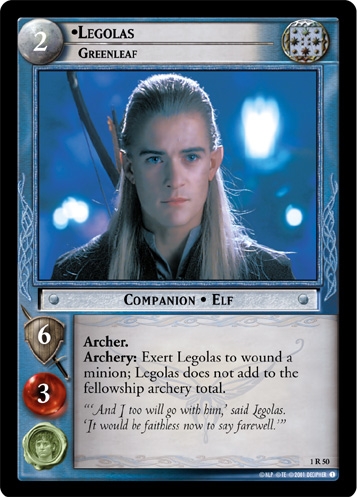 , Éowyn, Lady of Ithilien (10R72)
, Éowyn, Lady of Ithilien (10R72)
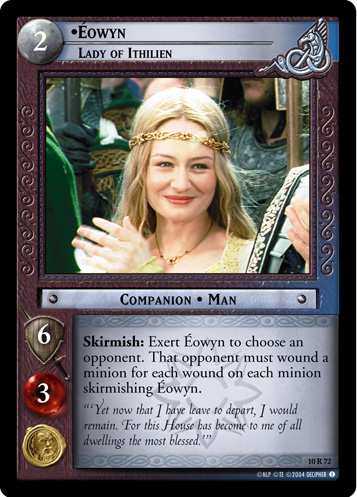 , and Sméagol, Always Helps (7R71)
, and Sméagol, Always Helps (7R71)
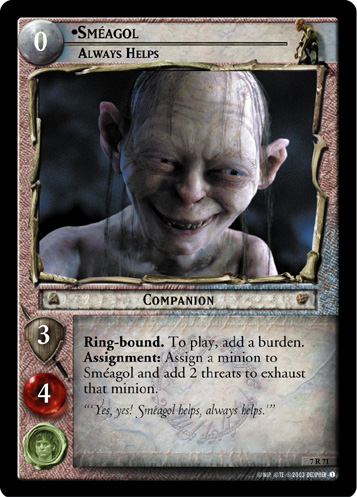 .
.
The core plan is to kill minions off before their skirmishes resolve. This can mean softening them up with Slaked Thirsts (7U14)
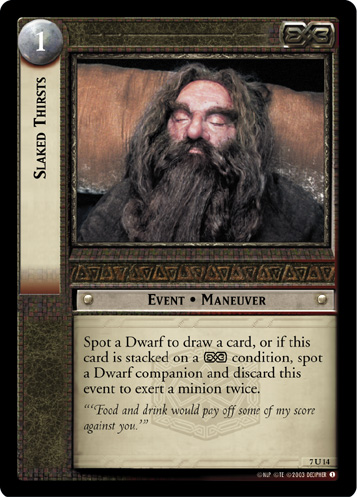 , then finishing them off with Legolas, Greenleaf (1R50)
, then finishing them off with Legolas, Greenleaf (1R50)
 . Or softening up a high-vitality minion with Greenleaf then skirmishing that minion with Éowyn, Lady of Ithilien (10R72)
. Or softening up a high-vitality minion with Greenleaf then skirmishing that minion with Éowyn, Lady of Ithilien (10R72)
 to wipe out many minions at once with her ability. It can happen entirely in the skirmish phase, with Smeagol, Always Hopes
to wipe out many minions at once with her ability. It can happen entirely in the skirmish phase, with Smeagol, Always Hopes
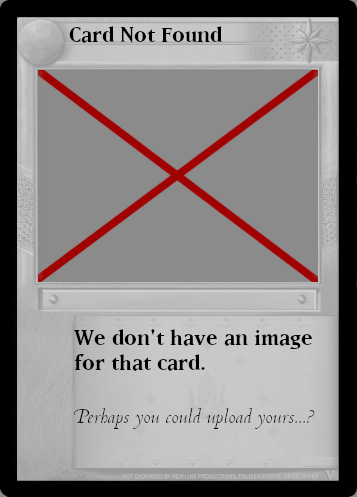 exhausting a minion then finishing it off with Don’t Look at Them (6R39)
exhausting a minion then finishing it off with Don’t Look at Them (6R39)
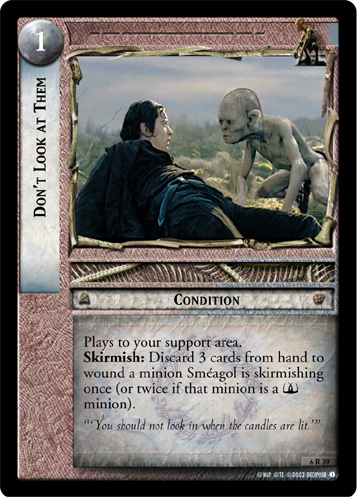 . Or it can even happen in the Shadow Phase, with one or more Shadowplay (10U114)
. Or it can even happen in the Shadow Phase, with one or more Shadowplay (10U114)
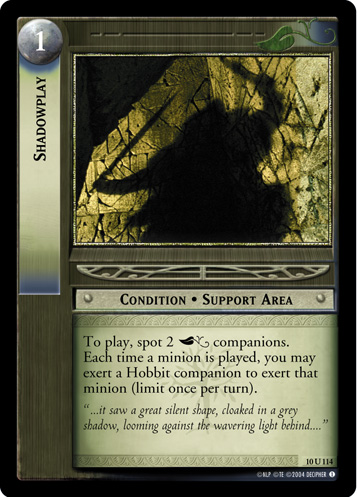 activations followed by an Underfoot
activations followed by an Underfoot
 finisher. Oftentimes, if a minion is dangerous because of an exertion ability rather than because of its strength in a skirmish, just exerting it first can be enough.
finisher. Oftentimes, if a minion is dangerous because of an exertion ability rather than because of its strength in a skirmish, just exerting it first can be enough.
This gameplan is risky. If minions are too tough or numerous to kill with direct wounds, or simply immune, then you may be left scrambling to deal with them with low-strength, often-exhausted companions. But once it gets rolling, it makes double moves very efficiently, since all of the minions are dead! It also very effectively shuts down many strategies that use one minion to buff another, or rely on spotting a minion in play to execute some sort of strategy. Plus, if a minion is dead, who cares what its strength was?
The deck also often makes extensive use of the initiative conditions from Mount Doom: Hardy Garrison (10U33)
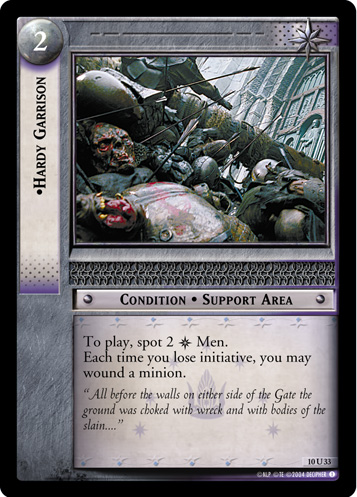 , A Light in His Mind (10U108)
, A Light in His Mind (10U108)
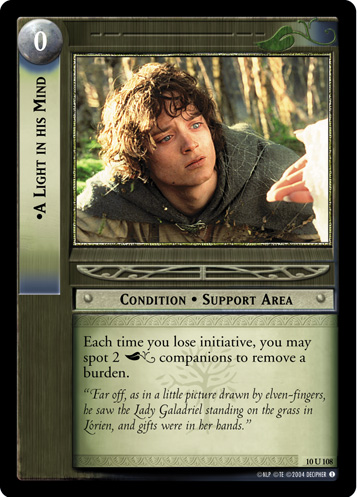 , Glimpse of Fate (10U12)
, Glimpse of Fate (10U12)
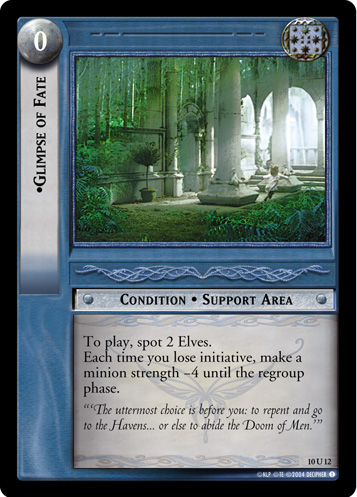 , and sometimes Brooding on Tomorrow (10U15)
, and sometimes Brooding on Tomorrow (10U15)
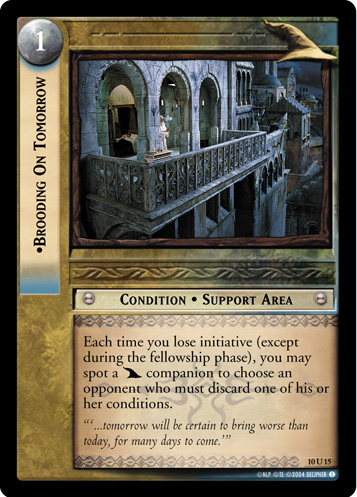 .
.
Greenleaf and Elven Support
Legolas, Greenleaf (1R50)
 is a powerful card just on his base ability. He's always good for at least one wound, and he can pick off troublesome two-vitality characters on his own with no support. Give him cards that increase his vitality, like The Tale of Gil-galad (1R66)
is a powerful card just on his base ability. He's always good for at least one wound, and he can pick off troublesome two-vitality characters on his own with no support. Give him cards that increase his vitality, like The Tale of Gil-galad (1R66)
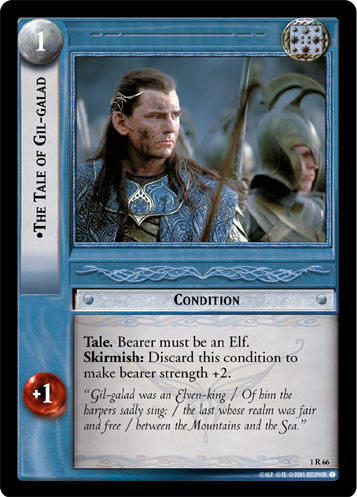 or Aeglos
or Aeglos
 , and he can handle even larger minions. You don't have to stop there; he can be supported with a larger Elven
, and he can handle even larger minions. You don't have to stop there; he can be supported with a larger Elven
 contingent.
contingent.
Elves have powerful, splashable healing to enable Greenleaf or other companions. Elrond, Herald to Gil-galad (3R13)
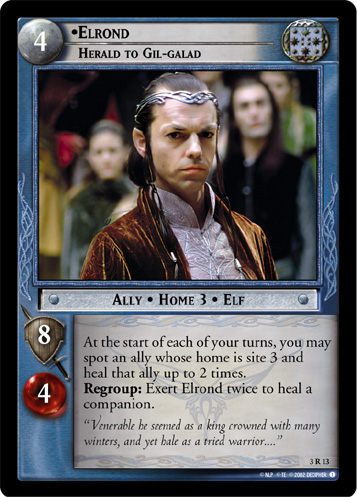 can fit into any deck, and opens up the possibility of including strong condition removal like Vilya (3R27)
can fit into any deck, and opens up the possibility of including strong condition removal like Vilya (3R27)
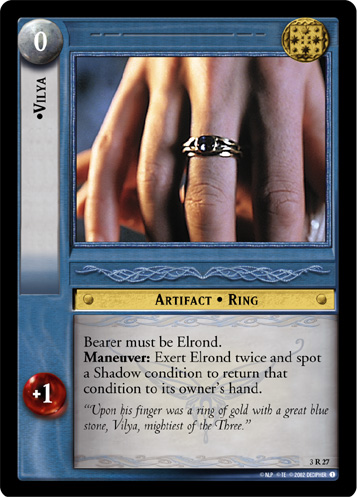 or Secret Sentinels (2R20)
or Secret Sentinels (2R20)
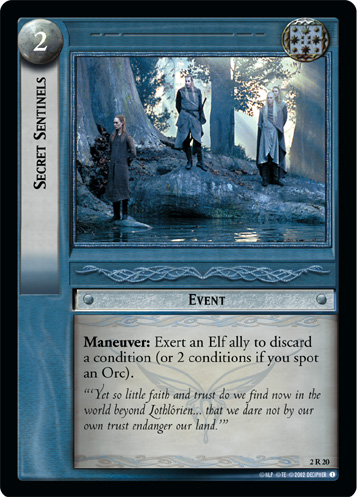 .
. Elven culture has even more healing options that work only on elves, like the strong cycling tool Shadow Between (7R28)
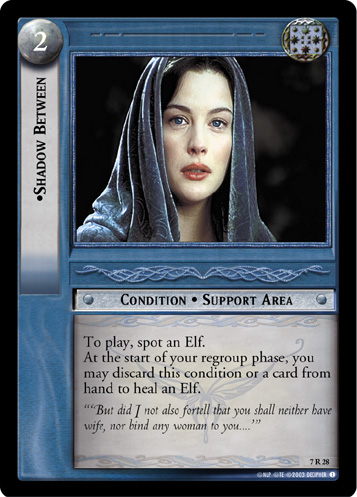 If your deck has a dwarf like Gimli, Bearer of Grudges (9R+4)
If your deck has a dwarf like Gimli, Bearer of Grudges (9R+4)
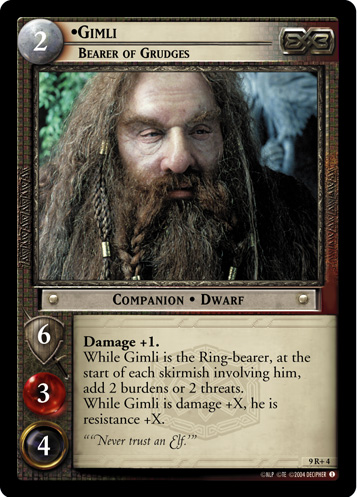 , you can also transfer wounds off of Greenleaf with Shoulder to Shoulder (1C59)
, you can also transfer wounds off of Greenleaf with Shoulder to Shoulder (1C59)
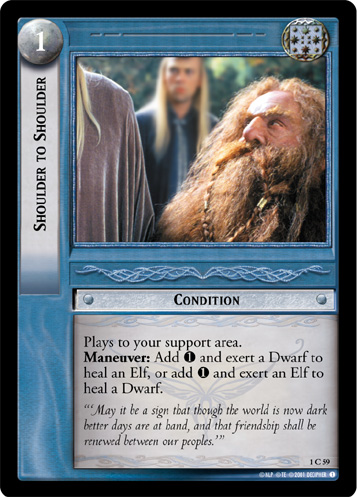 , often to allies like Herald to Gil-Galad. If you're running Shoulder to Shoulder already, then Elven
, often to allies like Herald to Gil-Galad. If you're running Shoulder to Shoulder already, then Elven
 allies like Rúmil, Elven Protector (1U57)
allies like Rúmil, Elven Protector (1U57)
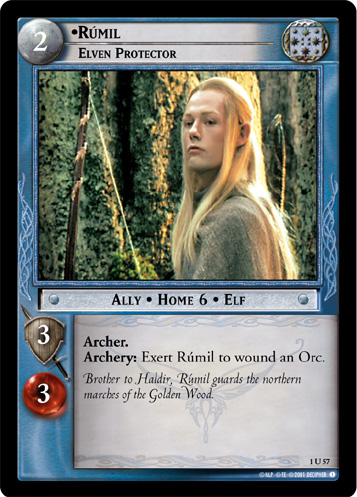 or maybe Orophin, Lorien Bowman (1U56)
or maybe Orophin, Lorien Bowman (1U56)
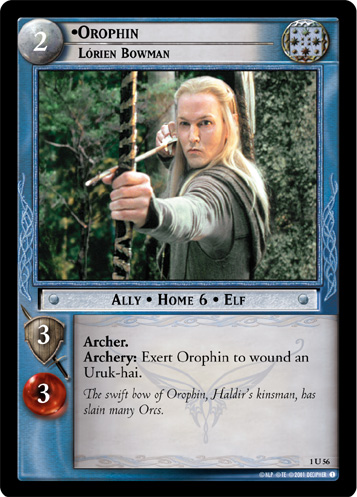 become more attractive. If you can't use their abilities because of your opponent's Shadow deck, then just use them as wound batteries!
become more attractive. If you can't use their abilities because of your opponent's Shadow deck, then just use them as wound batteries!
Greenleaf also has a Frodo signet, so you can defend him in a skirmish with some of the Frodo signet events discussed below, like Mind Your Own Affairs (4U312)
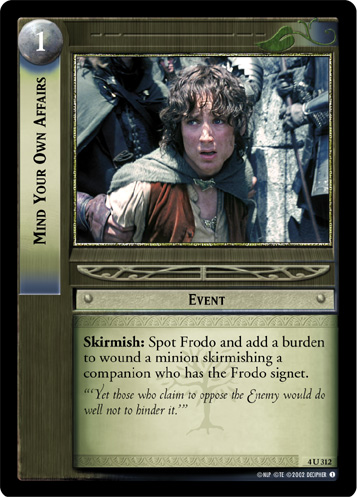 and No Use That Way (5R113)
and No Use That Way (5R113)
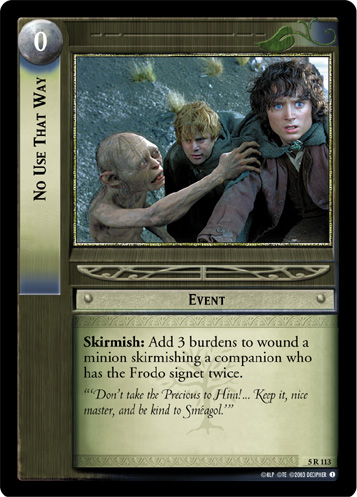 . If you're doing that, then Bow of the Galadhrim (1R33)
. If you're doing that, then Bow of the Galadhrim (1R33)
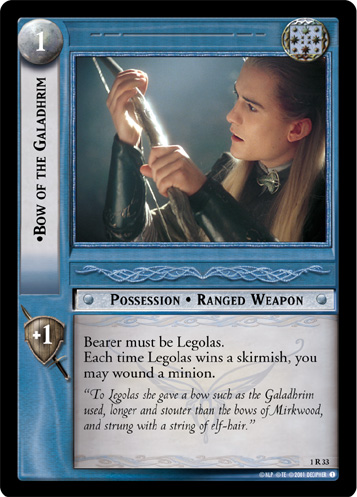 may be an option: if you kill the minion Legolas is skirmishing with a skirmish event, then you can wound another minion in another skirmish too.
may be an option: if you kill the minion Legolas is skirmishing with a skirmish event, then you can wound another minion in another skirmish too.
Legolas can use Double Shot (1R38)
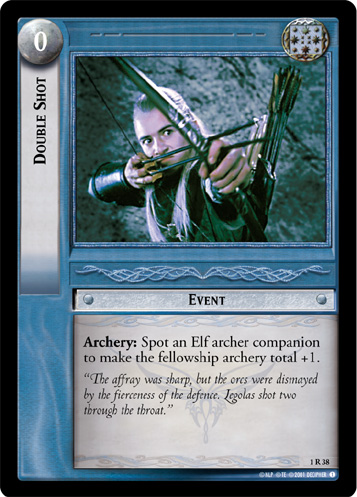 to get an additional undirected wound, but most of the other
to get an additional undirected wound, but most of the other Elven archery cards have too much cultural enforcement to work in a rainbow deck. He's terrible at using The Splendor of Their Banners (1R62)
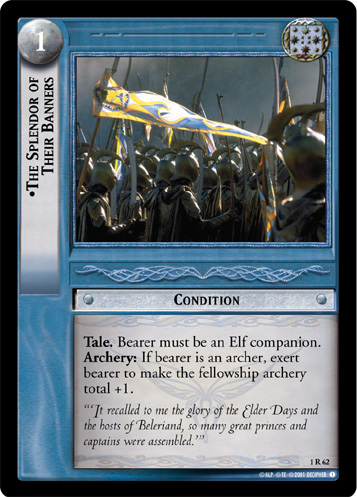 since it conflicts with his inherent exertion ability, and you need a lot of elf companions for cards like Elven Bow (1C41)
since it conflicts with his inherent exertion ability, and you need a lot of elf companions for cards like Elven Bow (1C41)
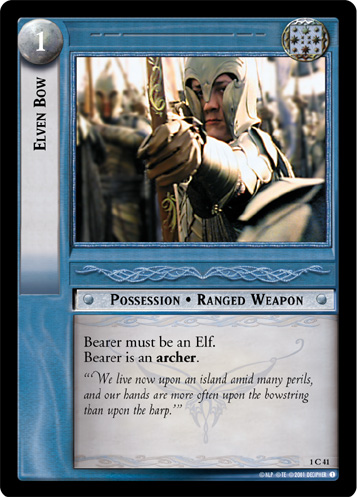 or Break the Charge (5R11)
or Break the Charge (5R11)
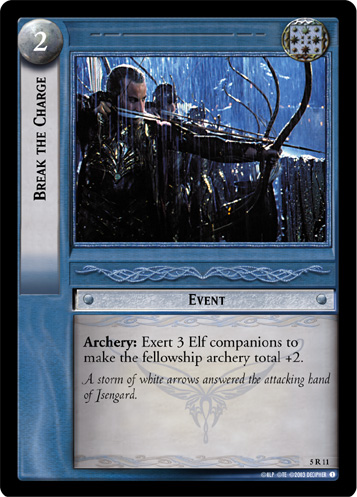 .
.
While it isn't strictly a wounding card, Glimpse of Fate (10U12)
 only requires that you have two elves in play to play it, so Greenleaf and an elf ally are sufficient. And if Greenleaf dies afterward, it still keeps working just fine. Rainbow decks in Movie Block are often running multiples of these conditions, oftentimes with a discard outlet (like Don’t Look at Them (6R39)
only requires that you have two elves in play to play it, so Greenleaf and an elf ally are sufficient. And if Greenleaf dies afterward, it still keeps working just fine. Rainbow decks in Movie Block are often running multiples of these conditions, oftentimes with a discard outlet (like Don’t Look at Them (6R39)
 ) to activate them. If you need a discard outlet, to activate these initiative conditions or simply to cycle your hand, Elven Sword (4C64)
) to activate them. If you need a discard outlet, to activate these initiative conditions or simply to cycle your hand, Elven Sword (4C64)
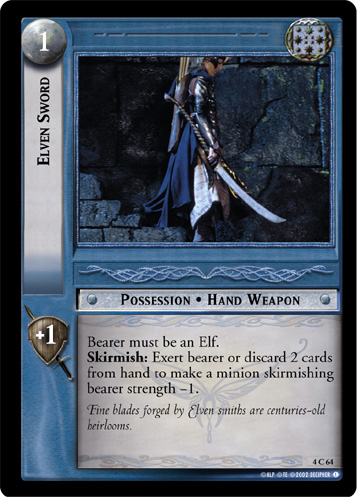 is an option, although Legolas is a poor skirmisher.
is an option, although Legolas is a poor skirmisher.
Rainbow Wounding often runs a tank companion or two to help manage enemies that can't be wounded or are simply immune to direct wounding. Arwen, Queen of Elves and Men (10R6)
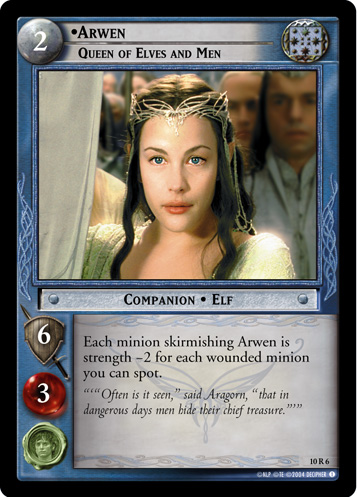 is one option for that role, especially with her strong possessions like Gwemegil (1R47)
is one option for that role, especially with her strong possessions like Gwemegil (1R47)
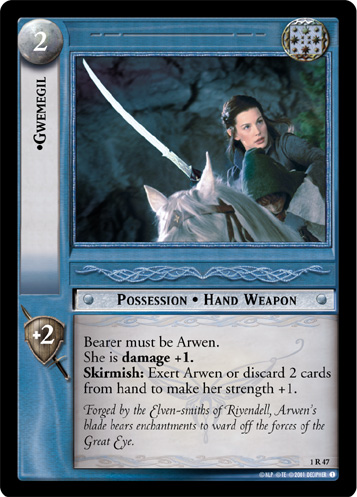 and Asfaloth (1U31)
and Asfaloth (1U31)
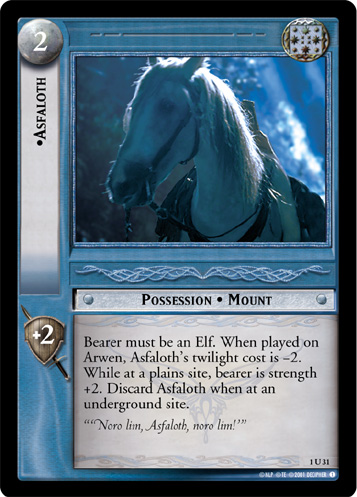 /Asfaloth, Elven Steed (7R17)
/Asfaloth, Elven Steed (7R17)
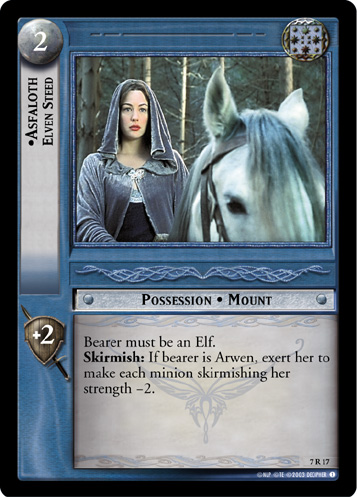 . Another choice is Glorfindel, Revealed in Wrath (9R+16)
. Another choice is Glorfindel, Revealed in Wrath (9R+16)
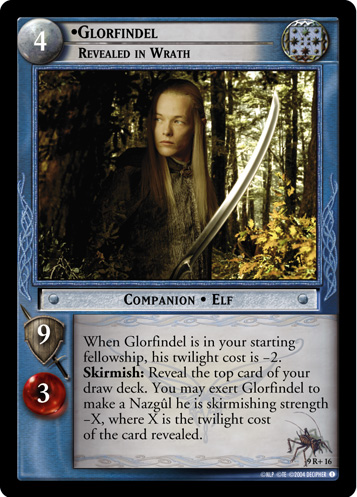 , who is cheap, efficient, and also needs no support. Alternately, if you're running a largish elven contingent, The Last Alliance of Elves and Men (1R49)
, who is cheap, efficient, and also needs no support. Alternately, if you're running a largish elven contingent, The Last Alliance of Elves and Men (1R49)
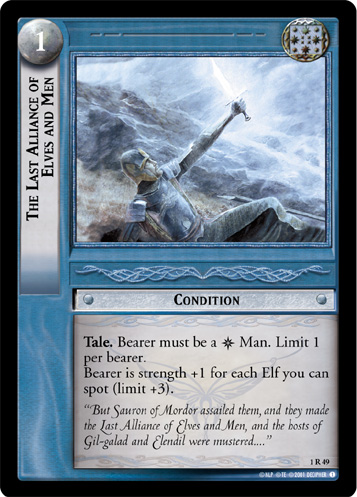 on a
on a Gondor companion is an option. (At some point, though, that deck goes from being Rainbow Wounding to an Elfman deck.)
Lady of Ithilien and Rohan support
If Greenleaf snipes minions, Éowyn, Lady of Ithilien (10R72)
 is carelessly flinging around grenades. While she's technically dealing undirected wounds (and your opponent will often try to kill off other, unimportant minions rather than the one she's skirmishing!), she does so much damage that she can finish off multiple badly-wounded minions at a time. She's one of the main cards that pushes Rainbow Wounding over the line, since on a good day she can nearly double or more the damage you've already done this turn. She can even set up wounds herself to some degree with supporting cards like Brego (4U263)
is carelessly flinging around grenades. While she's technically dealing undirected wounds (and your opponent will often try to kill off other, unimportant minions rather than the one she's skirmishing!), she does so much damage that she can finish off multiple badly-wounded minions at a time. She's one of the main cards that pushes Rainbow Wounding over the line, since on a good day she can nearly double or more the damage you've already done this turn. She can even set up wounds herself to some degree with supporting cards like Brego (4U263)
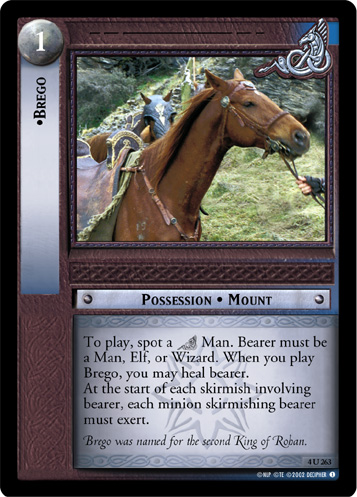 (which might as well be her matching mount), Éowyn's Sword, Dernhelm's Blade (7R230)
(which might as well be her matching mount), Éowyn's Sword, Dernhelm's Blade (7R230)
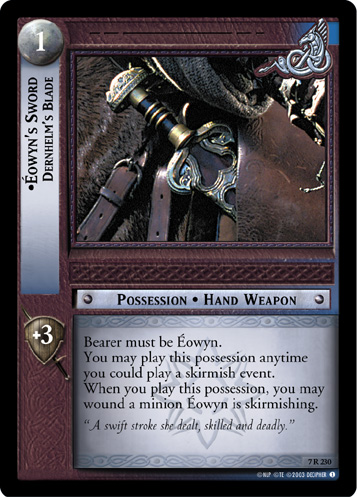 , and Rohirrim Javelin (7C248)
, and Rohirrim Javelin (7C248)
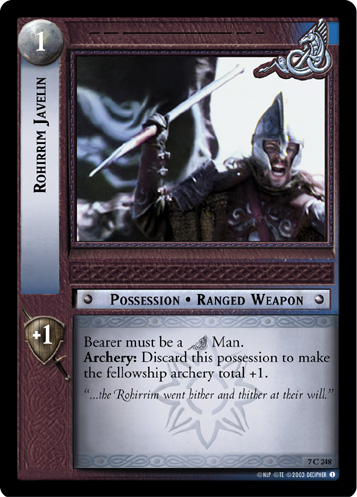 .
.
She does need some healing, and there are some strong Rohan options to do so, like Léowyn (7R239)
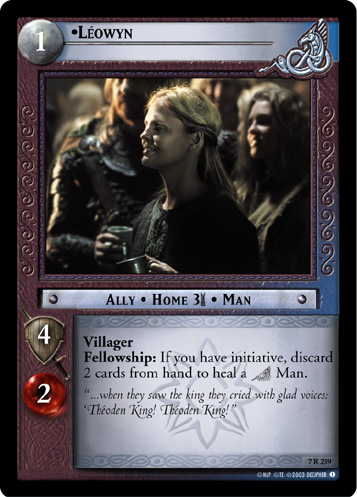 and Rohirrim Shield (5C91)
and Rohirrim Shield (5C91)
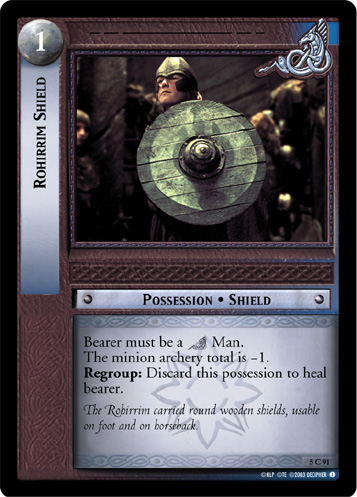 . She can also use Rohirrim Helm (5R89)
. She can also use Rohirrim Helm (5R89)
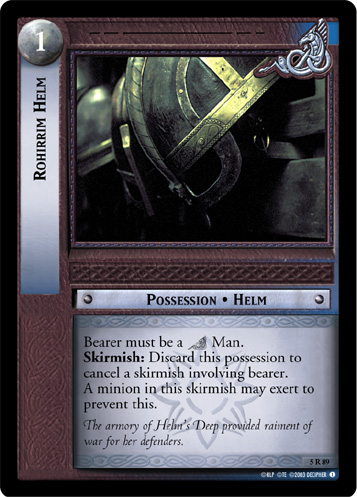 to force your opponent to make an unpleasant choice: either she exerts a minion (which will doubtless immediately be doubled by her ability), or she escapes an unwanted skirmish. If the minion is exhausted already, she just gets off scot-free. Merry, Swordthain (7R321)
to force your opponent to make an unpleasant choice: either she exerts a minion (which will doubtless immediately be doubled by her ability), or she escapes an unwanted skirmish. If the minion is exhausted already, she just gets off scot-free. Merry, Swordthain (7R321)
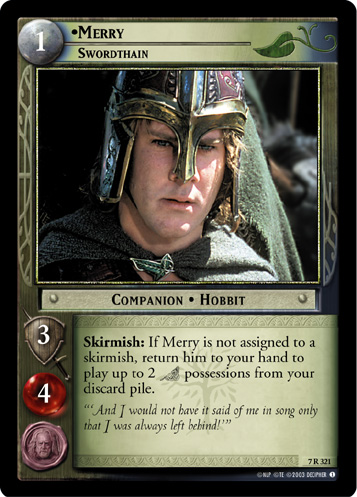 is technically a
is technically a Shire card (and is discussed more below), but can repeatedly retrieve all of these disposable possessions for reuse. If you're stacking possessions on her, you'll need some protection against Gríma, Wormtongue (4R154)
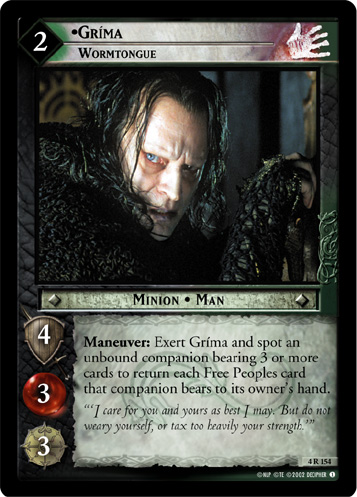 , but
, but Shire or
Dwarven cards (also discussed below) can do that.
Rohan doesn't have much for wounding tools beyond Lady of Ithilien, though. Rohirrim Javelin (7C248)
 (retrieved by Merry) and possibly Aldor, Soldier of Edoras (4R262)
(retrieved by Merry) and possibly Aldor, Soldier of Edoras (4R262)
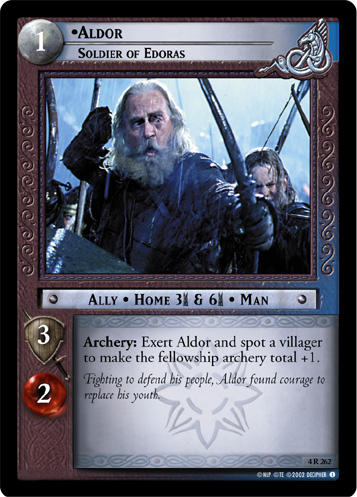 can add a few points of archery. Rainbow Wounding doesn't usually run Merry's Sword (7R242)
can add a few points of archery. Rainbow Wounding doesn't usually run Merry's Sword (7R242)
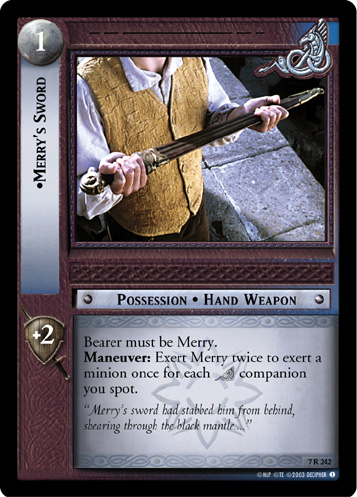 despite its strength, due to a lack of appropriate companions to spot. They do, however, have Éomer, Third Marshal of Riddermark (4R267)
despite its strength, due to a lack of appropriate companions to spot. They do, however, have Éomer, Third Marshal of Riddermark (4R267)
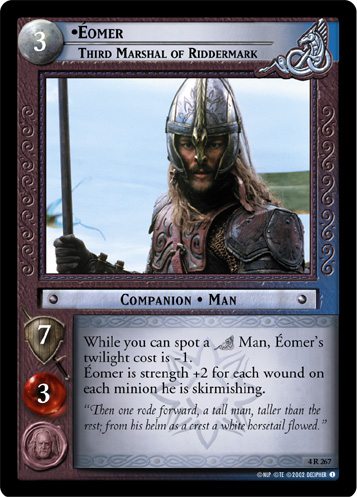 , a strong tank who benefits from having wounded minions to skirmish. And, while the
, a strong tank who benefits from having wounded minions to skirmish. And, while the Rohan initiative card, Fell Deeds Awake (10U73)
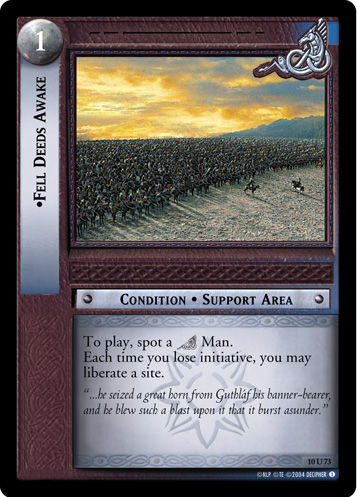 , is fairly weak, they have strong tools to manipulate initiative, like Léowyn (7R239)
, is fairly weak, they have strong tools to manipulate initiative, like Léowyn (7R239)
 and Déor (7C222)
and Déor (7C222)
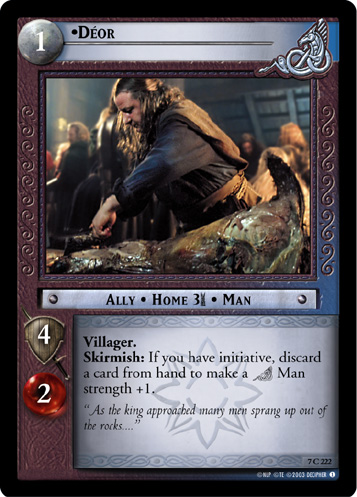 .
.
Good Sméagol Always Helps
Sméagol, Always Helps (7R71)
 is a strong addition to any Rainbow Wounding deck. Not only because he wounds minions, first exhausting them with his game text then killing them with a direct-wounding card, but also because of the costs involved in doing so. Rather than exerting himself (and requiring healing), he generates threats and consumes cards in hand. He can also deal with often-troublesome high-vitality minions, especially Enduring ones, like Shelob, Her Ladyship (10R23)
is a strong addition to any Rainbow Wounding deck. Not only because he wounds minions, first exhausting them with his game text then killing them with a direct-wounding card, but also because of the costs involved in doing so. Rather than exerting himself (and requiring healing), he generates threats and consumes cards in hand. He can also deal with often-troublesome high-vitality minions, especially Enduring ones, like Shelob, Her Ladyship (10R23)
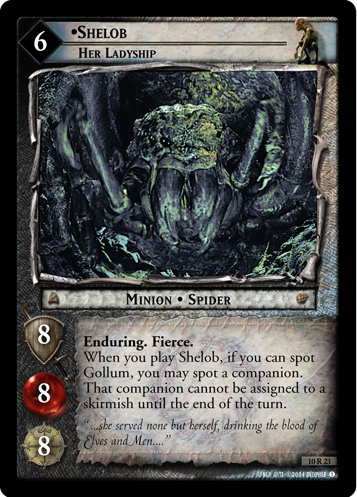 (assuming he doesn't get excluded from skirmishes by her!) and Sauron, The Lord of the Rings (9R+48)
(assuming he doesn't get excluded from skirmishes by her!) and Sauron, The Lord of the Rings (9R+48)
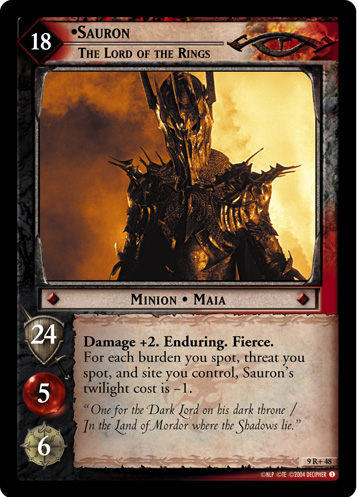 .
.
His game text only exhausts minions, and, with his low strength, he may still be in danger. The challenge is finding that last wound. The usual tool is Don’t Look at Them (6R39)
 , which is powerful (often enough to kill minions on its own!) and cycles unneeded cards out of your hand, but can usually only be used once or twice a turn. You can also finish off minions with Where Shall We Go (7U78)
, which is powerful (often enough to kill minions on its own!) and cycles unneeded cards out of your hand, but can usually only be used once or twice a turn. You can also finish off minions with Where Shall We Go (7U78)
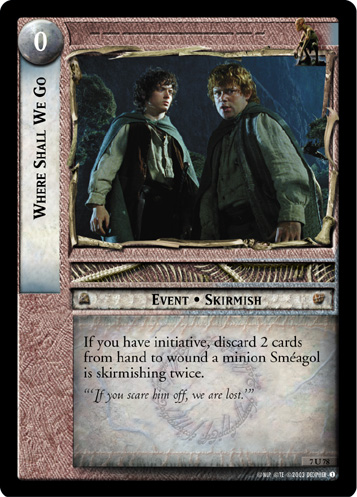 , or because he has a Frodo signet, No Use That Way (5R113)
, or because he has a Frodo signet, No Use That Way (5R113)
 . A
. A Shire contingent in your deck means you can also finish off a minion he's exhausted with Mind Your Own Affairs (4U312)
 or Unheeded (8R115)
or Unheeded (8R115)
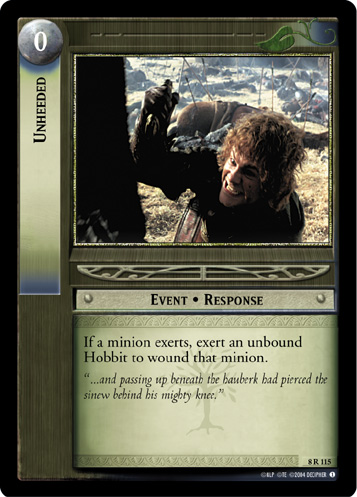 . Since the exhausting happens when Sméagol is assigned and not when he actually resolves his skirmish, Éowyn, Lady of Ithilien (10R72)
. Since the exhausting happens when Sméagol is assigned and not when he actually resolves his skirmish, Éowyn, Lady of Ithilien (10R72)
 or Bow of the Galadhrim (1R33)
or Bow of the Galadhrim (1R33)
 can snipe the minion before it becomes time for him to skirmish.
can snipe the minion before it becomes time for him to skirmish.
If Sméagol wins his skirmish, he has powerful tools that trigger from that. Don’t Follow the Lights (6C38)
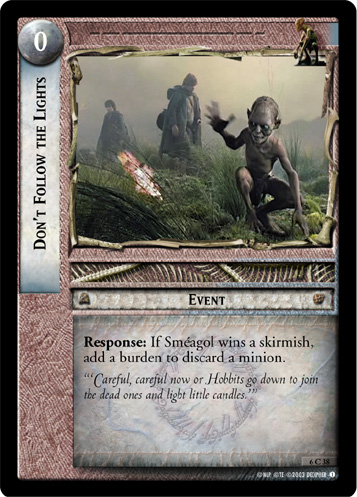 can pick off another minion with no need for wounding. Not Listening (6C43)
can pick off another minion with no need for wounding. Not Listening (6C43)
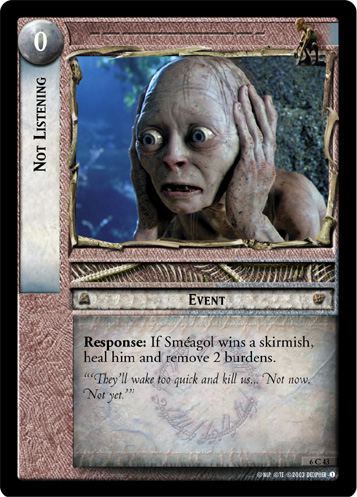 can heal him and remove the burdens placed by the
can heal him and remove the burdens placed by the Shire direct wounding cards (which, in turn, can activate The Shire Countryside (3R113)
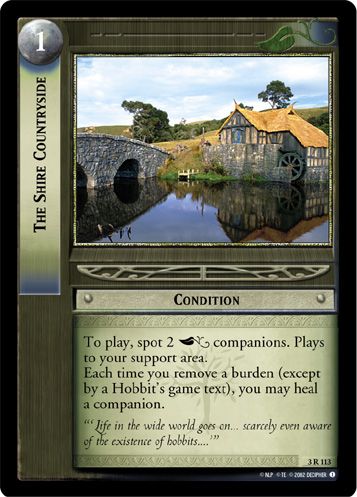 for more healing, in a
for more healing, in a Shire deck.)
While Sméagol relies on a card combo to do any work, he's not much of a downside the rest of the time. He's just generating one twilight per move, and only costs one burden to play. The worst thing that happens is that he might get killed, but that's one minion that wasn't contributing to an overwhelm on some other companion. He's best with hobbits, who often already have tools that can help protect him like Merry, Friend to Sam (1R302)
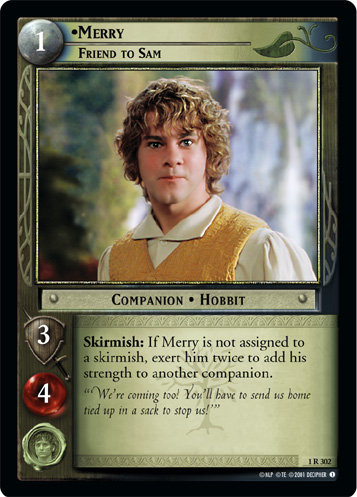 on top of the synergistic wounding tools, but he can work well with any culture on his own.
on top of the synergistic wounding tools, but he can work well with any culture on his own.
Hobbits
The hobbits of the Shire have a variety of direct wounding tools, as well as two different strong healing engines, one of which also tidily cleans up any excess burdens in the process. All of this power comes at the cost of needing to protect the vulnerable, low-strength hobbits, but that's what all the wounding and healing is for, right?
Firstly, there are the "bouncing" hobbits that can send themselves back to your hand: Pippin, Wearer of Black and Silver (7R324)
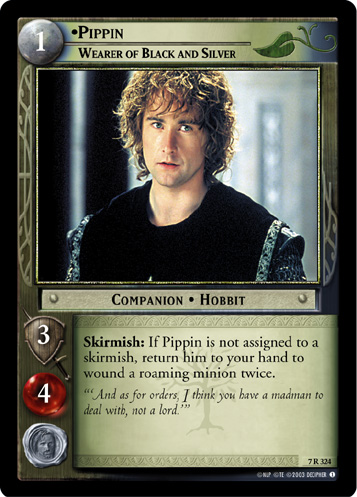 and Merry, Swordthain (7R321)
and Merry, Swordthain (7R321)
 . WOBAS can help fend off a dangerous minion at early sites (as long as it isn't a Nazgul), and Merry can help re-arm Éowyn, Lady of Ithilien (10R72)
. WOBAS can help fend off a dangerous minion at early sites (as long as it isn't a Nazgul), and Merry can help re-arm Éowyn, Lady of Ithilien (10R72)
 if her possessions are discarded. But, more importantly, when they return to your hand, all of their wounds are wiped clean. You don't even need a roaming minion to send WOBAS back to your hand; you can just use his ability whenever you like, as long as he's not currently assigned to a skirmish. You can use this to soak undirected wounds like archery, but that vitality can be put to more proactive use.
if her possessions are discarded. But, more importantly, when they return to your hand, all of their wounds are wiped clean. You don't even need a roaming minion to send WOBAS back to your hand; you can just use his ability whenever you like, as long as he's not currently assigned to a skirmish. You can use this to soak undirected wounds like archery, but that vitality can be put to more proactive use.
Shadowplay (10U114)
 can exert exert your hobbits to exert enemy minions when they come into play, often preventing those from even using Shadow Phase exertion abilities. Since this is happening so early in the turn, it can enable almost any other Free Peoples direct wounding card in the game, especially Legolas, Greenleaf (1R50)
can exert exert your hobbits to exert enemy minions when they come into play, often preventing those from even using Shadow Phase exertion abilities. Since this is happening so early in the turn, it can enable almost any other Free Peoples direct wounding card in the game, especially Legolas, Greenleaf (1R50)
 and Lady of Ithilien above. On top of this, Unheeded (8R115)
and Lady of Ithilien above. On top of this, Unheeded (8R115)
 can cut in and kill minions at any time as long as they're exerting, be it from your cards or Shadow cards. These abilities aren't just strong ways to keep from having to skirmish minions: they can also protect your deck from targeted hate cards like Gríma, Chief Counselor (5R51)
can cut in and kill minions at any time as long as they're exerting, be it from your cards or Shadow cards. These abilities aren't just strong ways to keep from having to skirmish minions: they can also protect your deck from targeted hate cards like Gríma, Chief Counselor (5R51)
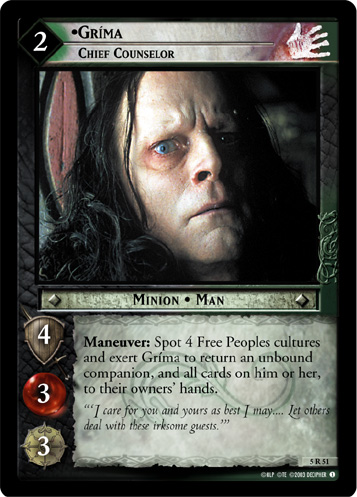 , Gríma, Wormtongue (4R154)
, Gríma, Wormtongue (4R154)
 , or Úlairë Enquëa, Lieutenant of Morgul (1U231)
, or Úlairë Enquëa, Lieutenant of Morgul (1U231)
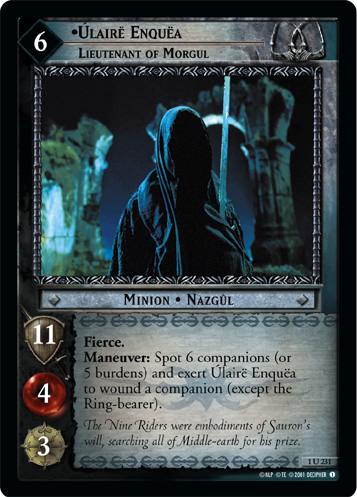 . Shadowplay/Unheeded with bouncing hobbits can be a self-sustaining source of wounds all game in a deck primarily focused on another culture, and if the hobbits end up being less useful, they can simply be discarded or thrown under the bus.
. Shadowplay/Unheeded with bouncing hobbits can be a self-sustaining source of wounds all game in a deck primarily focused on another culture, and if the hobbits end up being less useful, they can simply be discarded or thrown under the bus.
Shire
 culture also has strong skirmish wounding, generally based on placing burdens to wound minions who are skirmishing Frodo or Frodo-signet characters. Some of these don't even require any hobbits, despite being
culture also has strong skirmish wounding, generally based on placing burdens to wound minions who are skirmishing Frodo or Frodo-signet characters. Some of these don't even require any hobbits, despite being Shire cards: No Use That Way (5R113)
 can wound any minion skirmishing a Frodo-signet companion (like Greenleaf or Always Helps, above!) and Power According to His Stature (1R308)
can wound any minion skirmishing a Frodo-signet companion (like Greenleaf or Always Helps, above!) and Power According to His Stature (1R308)
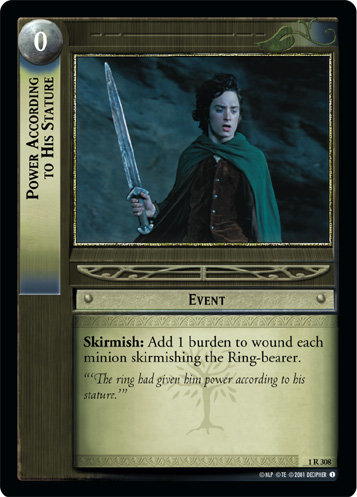 can wound minions skirmishing any ring-bearer, which is especially strong against swarm decks. Some do have a bit of cultural enforcement, though: Cliffs of Emyn Muil (4R299)
can wound minions skirmishing any ring-bearer, which is especially strong against swarm decks. Some do have a bit of cultural enforcement, though: Cliffs of Emyn Muil (4R299)
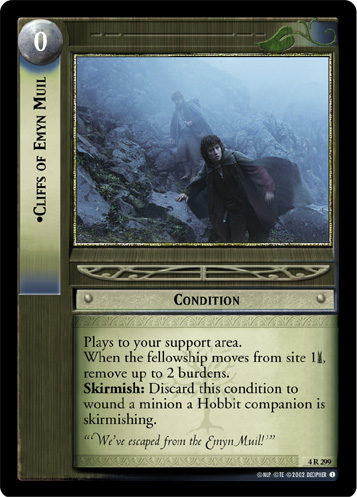 can wound any minion skirmishing any hobbit, and Mind Your Own Affairs (4U312)
can wound any minion skirmishing any hobbit, and Mind Your Own Affairs (4U312)
 spots Frodo to wound a minion skirmishing a Frodo-signet companion. All of these events can be recurred with Birthday Present (10R104)
spots Frodo to wound a minion skirmishing a Frodo-signet companion. All of these events can be recurred with Birthday Present (10R104)
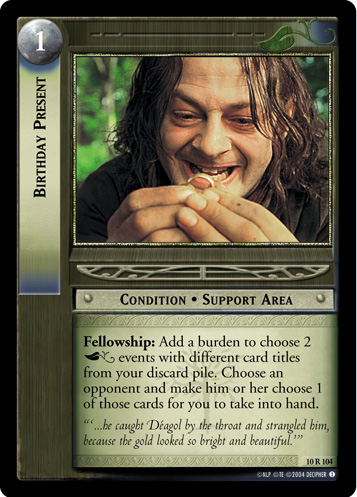 , albeit at the cost of even more burdens. Frodo, Wicked Masster! (7R318)
, albeit at the cost of even more burdens. Frodo, Wicked Masster! (7R318)
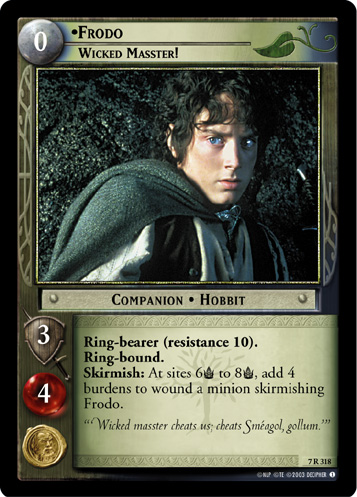 has a minion-wounding ability of his own, albeit at such a high cost that he is rarely played.
has a minion-wounding ability of his own, albeit at such a high cost that he is rarely played.
The burden costs end up being a soft form of cultural enforcement, however. Firstly, Frodo generally has the highest practical resistance of any ring-bearer in a rainbow deck, especially if you're playing Frodo, Resolute Hobbit (10P121)
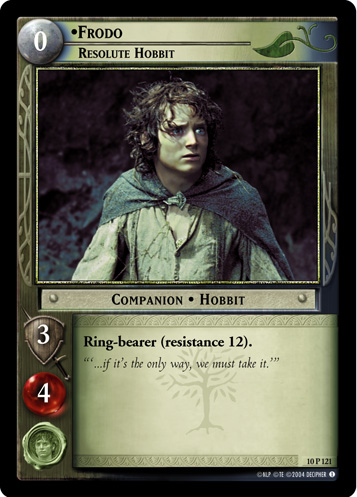 . But hobbits also have a very strong initiative condition that removes a burden almost every turn, sometimes more than once a turn: A Light in His Mind (10U108)
. But hobbits also have a very strong initiative condition that removes a burden almost every turn, sometimes more than once a turn: A Light in His Mind (10U108)
 . Sam, Resolute Halfling (7R327)
. Sam, Resolute Halfling (7R327)
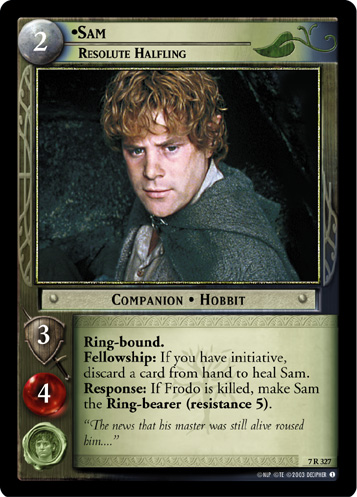 can activate it almost at will, while serving as a well of exertions for Shadowplay/Unheeded. That usually isn't enough burden removal on its own, but it can be supplemented with Frodo's Cloak (4R303)
can activate it almost at will, while serving as a well of exertions for Shadowplay/Unheeded. That usually isn't enough burden removal on its own, but it can be supplemented with Frodo's Cloak (4R303)
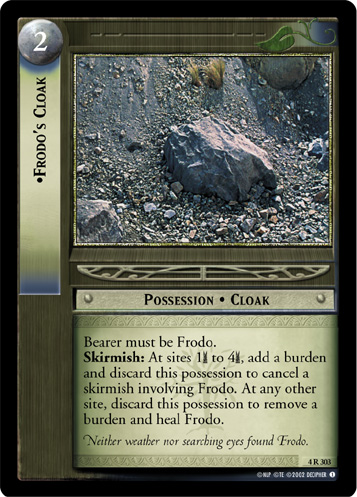 , Brace of Coneys (4C298)
, Brace of Coneys (4C298)
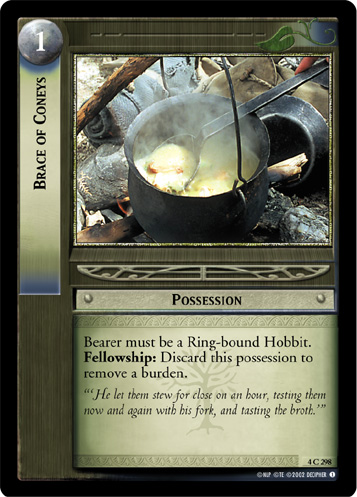 , Nine-fingered Frodo and the Ring of Doom (10C112)
, Nine-fingered Frodo and the Ring of Doom (10C112)
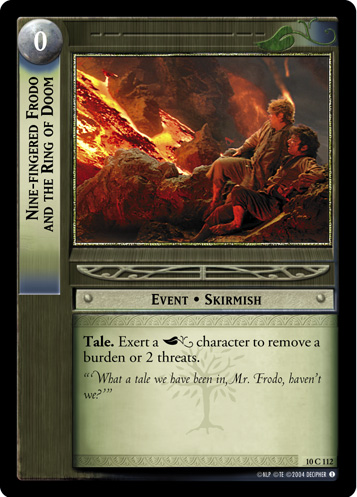 , and, if you're using Sméagol, Not Listening (6C43)
, and, if you're using Sméagol, Not Listening (6C43)
 . No Help for It (5R112)
. No Help for It (5R112)
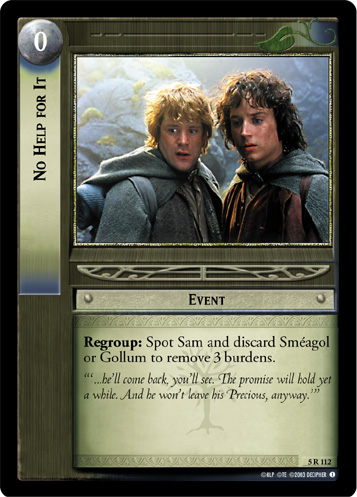 combined with Frodo, Master of the Precious (5U111)
combined with Frodo, Master of the Precious (5U111)
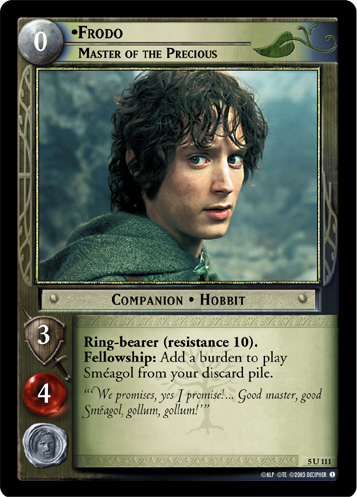 is another way to dump burdens while also healing Sméagol by replaying him.
is another way to dump burdens while also healing Sméagol by replaying him.
All of this burden removal may seem excessive, but you often want to place and remove as many burdens as possible because of another powerful Shire card: The Shire Countryside (3R113)
 . Every time you remove a burden, it heals a companion for each copy of Shire Countryside you have, which can turn into quite a lot of healing! Funnel that healing to a character with a powerful exert-to-wound ability, and you can mow down troublesome minions every turn.
. Every time you remove a burden, it heals a companion for each copy of Shire Countryside you have, which can turn into quite a lot of healing! Funnel that healing to a character with a powerful exert-to-wound ability, and you can mow down troublesome minions every turn.
Gimli and Slaked Thirsts
Gimli—almost always Gimli, Bearer of Grudges (9R+4)
 or Gimli, Feared Axeman (7R7)
or Gimli, Feared Axeman (7R7)
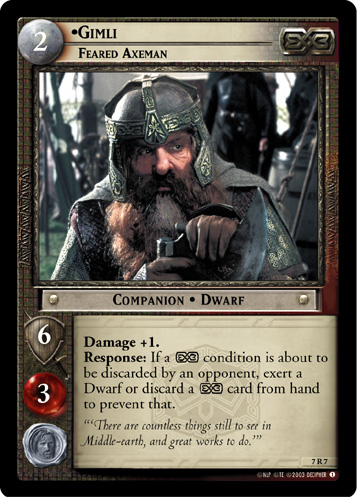 —can bring a lot to a Rainbow Wounding deck. The main benefit to having him is Preparations (7R12)
—can bring a lot to a Rainbow Wounding deck. The main benefit to having him is Preparations (7R12)
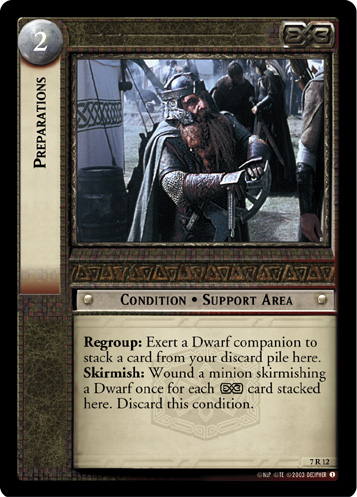 and Slaked Thirsts (7U14)
and Slaked Thirsts (7U14)
 . Not only is Slaked Thirsts a powerful card, placing two wounds for the cost of one exertion, you don't need to keep Gimli healthy to use it. You can make sure any excess healing (for example, from a sanctuary) won't go to waste by using it to place Slaked Thirsts on Preparations, and Bearer of Grudges with The One Ring, Answer To All Riddles (4R1)
. Not only is Slaked Thirsts a powerful card, placing two wounds for the cost of one exertion, you don't need to keep Gimli healthy to use it. You can make sure any excess healing (for example, from a sanctuary) won't go to waste by using it to place Slaked Thirsts on Preparations, and Bearer of Grudges with The One Ring, Answer To All Riddles (4R1)
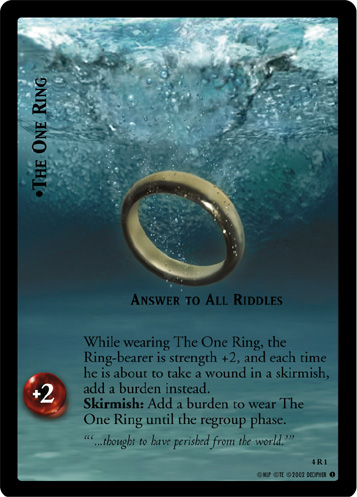 has a deep wound pool and is unlikely to take any unexpected wounds against many Shadow sides. Any extra copies of Preparations won't go to waste either, since they can be used as a (weak) direct-wounding card. If you draw Slaked Thirsts, you can play it when you have exactly three other cards in hand to quickly lose then regain initiative for the other cultures' initiative conditions. Like Shadowplay (10U114)
has a deep wound pool and is unlikely to take any unexpected wounds against many Shadow sides. Any extra copies of Preparations won't go to waste either, since they can be used as a (weak) direct-wounding card. If you draw Slaked Thirsts, you can play it when you have exactly three other cards in hand to quickly lose then regain initiative for the other cultures' initiative conditions. Like Shadowplay (10U114)
 above, Slaked Thirsts is a powerful tool for stymieing obnoxious hate cards like Gríma, Chief Counselor (5R51)
above, Slaked Thirsts is a powerful tool for stymieing obnoxious hate cards like Gríma, Chief Counselor (5R51)
 , Gríma, Wormtongue (4R154)
, Gríma, Wormtongue (4R154)
 , or Úlairë Enquëa, Lieutenant of Morgul (1U231)
, or Úlairë Enquëa, Lieutenant of Morgul (1U231)
 . Compared to Slaked Thirsts, the
. Compared to Slaked Thirsts, the Dwarven wounding cards are fairly anemic. Quick As May Be (4U53)
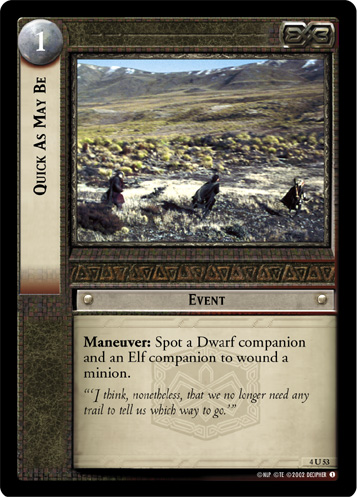 is cheap and basically free, so it's worth finding space for sometimes. Baruk Khazâd (5R5)
is cheap and basically free, so it's worth finding space for sometimes. Baruk Khazâd (5R5)
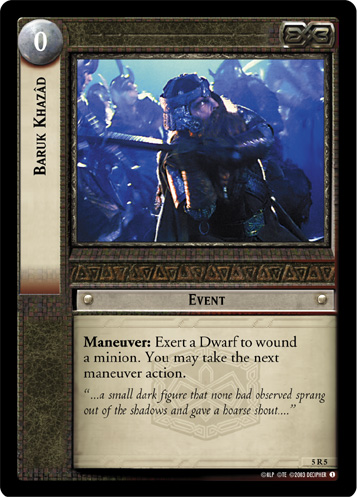 can be useful, but it isn't as strong as Slaked Thirsts and can't easily be replayed.
can be useful, but it isn't as strong as Slaked Thirsts and can't easily be replayed.
The next most-important reason to bring Gimli is Shoulder to Shoulder (1C59)
 . If you're bringing Legolas, Greenleaf (1R50)
. If you're bringing Legolas, Greenleaf (1R50)
 , the two of them can share their vitality pool for Greenleaf's exertion ability or Preparations. As with the
, the two of them can share their vitality pool for Greenleaf's exertion ability or Preparations. As with the Elven contingent above, adding in Elrond, Herald to Gil-galad (3R13)
 gives them a powerful source of healing every single turn, at the cost of generating some twilight in the Maneuver Phase.
gives them a powerful source of healing every single turn, at the cost of generating some twilight in the Maneuver Phase.
Having a single dwarf in your deck also opens up a lot of other cards, especially if your deck already has lots of healing or tends to generate some threats. Ever My Heart Rises (4R46)
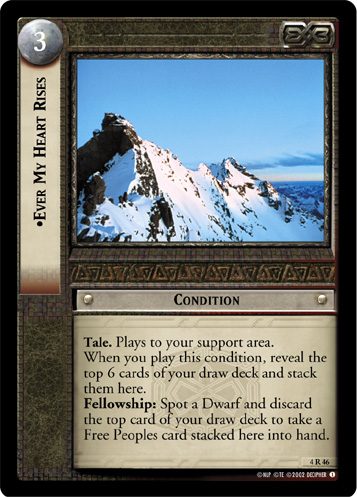 (generally downloaded with Dunharrow Plateau (7U329)
(generally downloaded with Dunharrow Plateau (7U329)
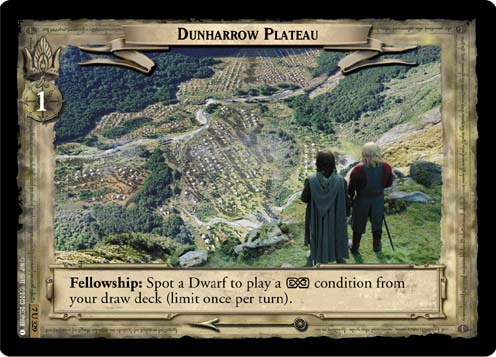 ) can help your deck set up more consistently to start, as long as you can don't mind milling yourself a little bit. Gimli's Battle Axe, Trusted Weapon (7R9)
) can help your deck set up more consistently to start, as long as you can don't mind milling yourself a little bit. Gimli's Battle Axe, Trusted Weapon (7R9)
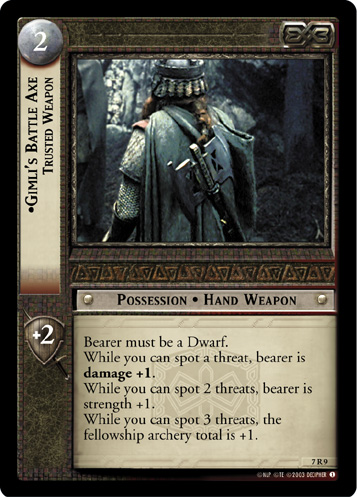 contributes an extra archery wound once some threats are stacked, although some decks instead use Axe of Erebor (4R41)
contributes an extra archery wound once some threats are stacked, although some decks instead use Axe of Erebor (4R41)
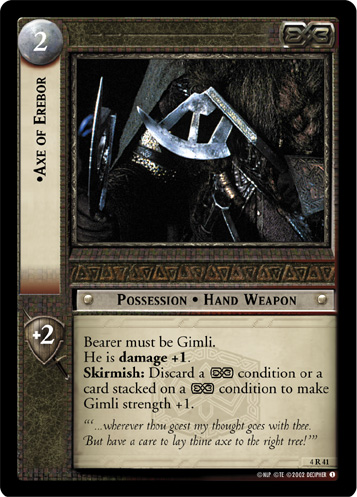 since it can get a strength bonus freeing up any Shadow cards stuck on EMHR, and some decks don't bother at all because of the possession hate in the format. Blood Runs Chill (8R3)
since it can get a strength bonus freeing up any Shadow cards stuck on EMHR, and some decks don't bother at all because of the possession hate in the format. Blood Runs Chill (8R3)
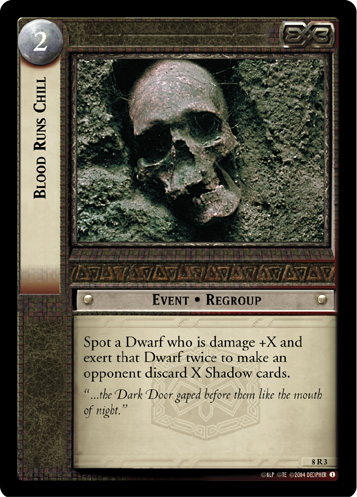 can discard some minions who survived the skirmish phase or clean out your opponent's support area. Ring of Fury (9R+7)
can discard some minions who survived the skirmish phase or clean out your opponent's support area. Ring of Fury (9R+7)
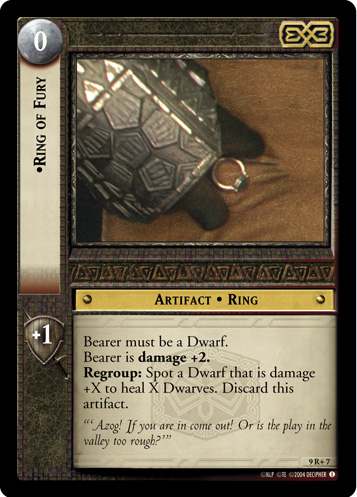 is a good choice to help protect Gimli, and it also boosts Blood Runs Chill and can be downloaded with The One Ring, The Binding Ring (9R+1)
is a good choice to help protect Gimli, and it also boosts Blood Runs Chill and can be downloaded with The One Ring, The Binding Ring (9R+1)
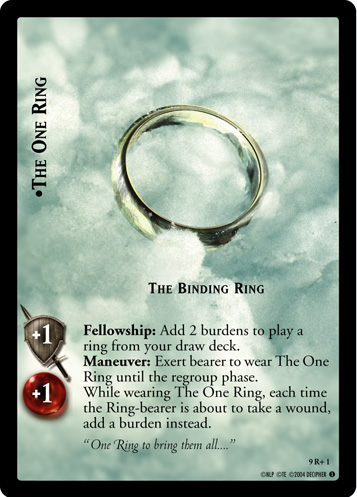 .
.
Aragorn, Faramir, and Gondorian tools
A Gondor contingent is often very small. Aragorn, Elessar Telcontar (10R25)
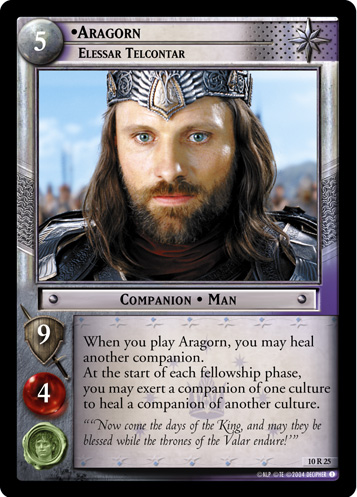 is a powerful skirmisher, and he can use Andúril, Flame of the West (7R79)
is a powerful skirmisher, and he can use Andúril, Flame of the West (7R79)
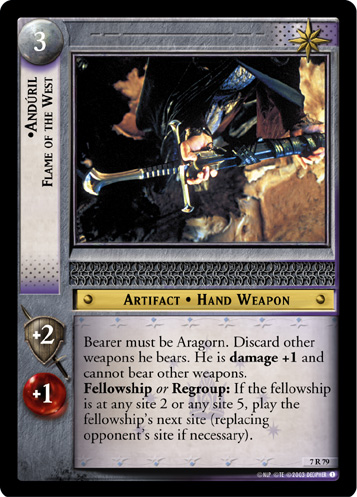 or Aragorn’s Bow (1R90)
or Aragorn’s Bow (1R90)
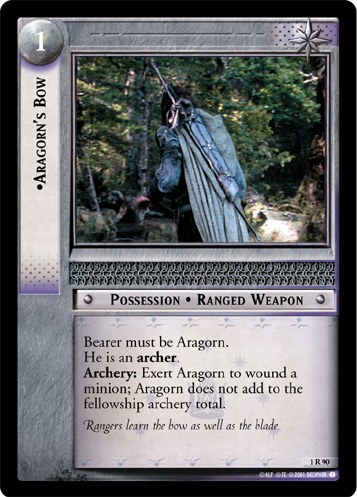 (although the latter is less common, due to pervasive
(although the latter is less common, due to pervasive
gimli RB or condition gimli - slaked thirsts, preparations, trusted weapon. can start EMHR or preparations. baruk khazad and quick as may be aragorn's bow - elessar telcontar or king in exile, gondor bowmen, hardy garrison, defend it and hope gandalf - mainly terrible and evil